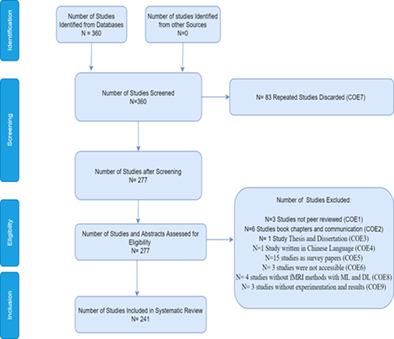当前位置:
X-MOL 学术
›
Expert Syst.
›
论文详情
Our official English website, www.x-mol.net, welcomes your feedback! (Note: you will need to create a separate account there.)
The use of machine learning and deep learning algorithms in functional magnetic resonance imaging—A systematic review
Expert Systems ( IF 3.3 ) Pub Date : 2020-10-15 , DOI: 10.1111/exsy.12644 Mamoon Rashid 1 , Harjeet Singh 2 , Vishal Goyal 3
Expert Systems ( IF 3.3 ) Pub Date : 2020-10-15 , DOI: 10.1111/exsy.12644 Mamoon Rashid 1 , Harjeet Singh 2 , Vishal Goyal 3
Affiliation

|
Functional Magnetic Resonance Imaging (fMRI) is presently one of the most popular techniques for analysing the dynamic states in brain images using various kinds of algorithms. From the last decade, there is an exponential rise in the use of the machine and deep learning algorithms of artificial intelligence for analysing fMRI data. However, it is a big challenge for every researcher to choose a suitable machine or deep learning algorithm for analysing fMRI data due to the availability of a large number of algorithms in the literature. It takes much time for each researcher to know about the various approaches and algorithms which are in use for fMRI data. This paper provides a review in a systematic manner for the present literature of fMRI data that makes use of the machine and deep learning algorithms. The major goals of this review paper are to (a) identify machine learning and deep learning research trends for the implementation of fMRI; (b) identify usage of Machine Learning Algorithms and deep learning in fMRI, and (c) help new researchers based on fMRI to put their new findings appropriately in existing domain of fMRI research. The results of this systematic review identified various fMRI studies and classified them based on fMRI types, mental diseases, use of machine learning and deep learning algorithms. The authors have provided the studies with the best performance of machine learning and deep learning algorithms used in fMRI. The authors believe that this systematic review will help incoming researchers on fMRI in their future works.
中文翻译:

机器学习和深度学习算法在功能磁共振成像中的使用-系统综述
功能磁共振成像(fMRI)是目前使用多种算法来分析大脑图像中动态状态的最流行技术之一。从最近的十年开始,用于分析fMRI数据的机器和人工智能深度学习算法的使用呈指数增长。但是,由于文献中提供了大量算法,因此对于每个研究人员来说,选择合适的机器或深度学习算法来分析fMRI数据都是一个很大的挑战。每个研究人员都需要花费很多时间来了解用于fMRI数据的各种方法和算法。本文系统地回顾了利用机器和深度学习算法的fMRI数据的现有文献。本文的主要目标是(a)识别用于功能磁共振成像的机器学习和深度学习研究趋势;(b)确定在fMRI中使用机器学习算法和深度学习,以及(c)帮助基于fMRI的新研究人员将其新发现适当地放入fMRI研究的现有领域。这项系统评价的结果确定了各种功能磁共振成像研究,并根据功能磁共振成像类型,精神疾病,机器学习的使用和深度学习算法对它们进行了分类。作者为这些研究提供了功能性磁共振成像中使用的机器学习和深度学习算法的最佳性能。作者认为,这一系统的综述将有助于功能磁共振成像的新进研究者未来的工作。(b)确定在fMRI中使用机器学习算法和深度学习,以及(c)帮助基于fMRI的新研究人员将其新发现适当地放入fMRI研究的现有领域。这项系统评价的结果确定了各种功能磁共振成像研究,并根据功能磁共振成像类型,精神疾病,机器学习的使用和深度学习算法对它们进行了分类。作者为这些研究提供了功能强大的机器学习和深度学习算法的最佳性能。作者认为,这一系统的综述将有助于功能磁共振成像的新进研究者未来的工作。(b)确定在fMRI中使用机器学习算法和深度学习,以及(c)帮助基于fMRI的新研究人员将其新发现适当地放入fMRI研究的现有领域。这项系统评价的结果确定了各种功能磁共振成像研究,并根据功能磁共振成像类型,精神疾病,机器学习的使用和深度学习算法对它们进行了分类。作者为这些研究提供了功能性磁共振成像中使用的机器学习和深度学习算法的最佳性能。作者认为,这一系统的综述将有助于功能磁共振成像的新进研究者未来的工作。这项系统评价的结果确定了各种功能磁共振成像研究,并根据功能磁共振成像类型,精神疾病,机器学习的使用和深度学习算法对它们进行了分类。作者为这些研究提供了功能性磁共振成像中使用的机器学习和深度学习算法的最佳性能。作者认为,这一系统的综述将有助于功能磁共振成像的新进研究者未来的工作。这项系统评价的结果确定了各种功能磁共振成像研究,并根据功能磁共振成像类型,精神疾病,机器学习的使用和深度学习算法对它们进行了分类。作者为这些研究提供了功能性磁共振成像中使用的机器学习和深度学习算法的最佳性能。作者认为,这一系统的综述将有助于功能磁共振成像的新进研究者未来的工作。
更新日期:2020-12-07
中文翻译:

机器学习和深度学习算法在功能磁共振成像中的使用-系统综述
功能磁共振成像(fMRI)是目前使用多种算法来分析大脑图像中动态状态的最流行技术之一。从最近的十年开始,用于分析fMRI数据的机器和人工智能深度学习算法的使用呈指数增长。但是,由于文献中提供了大量算法,因此对于每个研究人员来说,选择合适的机器或深度学习算法来分析fMRI数据都是一个很大的挑战。每个研究人员都需要花费很多时间来了解用于fMRI数据的各种方法和算法。本文系统地回顾了利用机器和深度学习算法的fMRI数据的现有文献。本文的主要目标是(a)识别用于功能磁共振成像的机器学习和深度学习研究趋势;(b)确定在fMRI中使用机器学习算法和深度学习,以及(c)帮助基于fMRI的新研究人员将其新发现适当地放入fMRI研究的现有领域。这项系统评价的结果确定了各种功能磁共振成像研究,并根据功能磁共振成像类型,精神疾病,机器学习的使用和深度学习算法对它们进行了分类。作者为这些研究提供了功能性磁共振成像中使用的机器学习和深度学习算法的最佳性能。作者认为,这一系统的综述将有助于功能磁共振成像的新进研究者未来的工作。(b)确定在fMRI中使用机器学习算法和深度学习,以及(c)帮助基于fMRI的新研究人员将其新发现适当地放入fMRI研究的现有领域。这项系统评价的结果确定了各种功能磁共振成像研究,并根据功能磁共振成像类型,精神疾病,机器学习的使用和深度学习算法对它们进行了分类。作者为这些研究提供了功能强大的机器学习和深度学习算法的最佳性能。作者认为,这一系统的综述将有助于功能磁共振成像的新进研究者未来的工作。(b)确定在fMRI中使用机器学习算法和深度学习,以及(c)帮助基于fMRI的新研究人员将其新发现适当地放入fMRI研究的现有领域。这项系统评价的结果确定了各种功能磁共振成像研究,并根据功能磁共振成像类型,精神疾病,机器学习的使用和深度学习算法对它们进行了分类。作者为这些研究提供了功能性磁共振成像中使用的机器学习和深度学习算法的最佳性能。作者认为,这一系统的综述将有助于功能磁共振成像的新进研究者未来的工作。这项系统评价的结果确定了各种功能磁共振成像研究,并根据功能磁共振成像类型,精神疾病,机器学习的使用和深度学习算法对它们进行了分类。作者为这些研究提供了功能性磁共振成像中使用的机器学习和深度学习算法的最佳性能。作者认为,这一系统的综述将有助于功能磁共振成像的新进研究者未来的工作。这项系统评价的结果确定了各种功能磁共振成像研究,并根据功能磁共振成像类型,精神疾病,机器学习的使用和深度学习算法对它们进行了分类。作者为这些研究提供了功能性磁共振成像中使用的机器学习和深度学习算法的最佳性能。作者认为,这一系统的综述将有助于功能磁共振成像的新进研究者未来的工作。



























 京公网安备 11010802027423号
京公网安备 11010802027423号